Can One to Dispose of Food Down the Toilet?
Can One to Dispose of Food Down the Toilet?
Blog Article
Each person will have his or her own rationale involving Flushing Food Down the Toilet?.

Intro
Many individuals are frequently confronted with the issue of what to do with food waste, specifically when it comes to leftovers or scraps. One usual concern that develops is whether it's fine to purge food down the commode. In this short article, we'll delve into the reasons individuals may consider purging food, the repercussions of doing so, and different techniques for correct disposal.
Reasons why people could consider flushing food
Absence of awareness
Some people may not be aware of the potential damage brought on by flushing food down the toilet. They may mistakenly think that it's a safe practice.
Ease
Flushing food down the commode might feel like a quick and simple remedy to taking care of undesirable scraps, especially when there's no nearby trash can offered.
Negligence
Sometimes, people might simply choose to flush food out of sheer laziness, without taking into consideration the consequences of their activities.
Effects of flushing food down the bathroom
Environmental influence
Food waste that winds up in rivers can contribute to air pollution and injury aquatic ecological communities. Furthermore, the water made use of to purge food can strain water sources.
Pipes issues
Purging food can bring about clogged pipelines and drains, creating costly plumbing repair work and hassles.
Kinds of food that should not be purged
Coarse foods
Foods with fibrous appearances such as celery or corn husks can obtain entangled in pipelines and create obstructions.
Starchy foods
Starchy foods like pasta and rice can absorb water and swell, resulting in blockages in pipelines.
Oils and fats
Greasy foods like bacon or cooking oils need to never ever be purged down the bathroom as they can strengthen and create clogs.
Correct disposal techniques for food waste
Using a waste disposal unit
For homes outfitted with garbage disposals, food scraps can be ground up and purged with the plumbing system. However, not all foods are suitable for disposal in this manner.
Recycling
Certain food product packaging materials can be recycled, decreasing waste and lessening ecological effect.
Composting
Composting is an environment-friendly means to dispose of food waste. Organic products can be composted and used to enhance dirt for gardening.
The significance of proper waste management
Lowering environmental damage
Proper waste management techniques, such as composting and recycling, aid decrease air pollution and preserve natural deposits for future generations.
Safeguarding plumbing systems
By avoiding the technique of flushing food down the toilet, home owners can protect against pricey plumbing repair work and keep the honesty of their plumbing systems.
Final thought
Finally, while it may be tempting to flush food down the toilet for convenience, it is very important to comprehend the possible consequences of this activity. By taking on appropriate waste administration techniques and throwing away food waste properly, individuals can add to healthier plumbing systems and a cleaner atmosphere for all.
FLUSH FOOD DOWN THE TOILET?
FLUSHING FOOD CAN CAUSE BLOCKED DRAINS IN YOUR HOME
All of the plumbing fixtures in your home are connected to the same sewer pipe outside of your home. This outdoor sewer pipe is responsible for transporting all the wastewater from your home to the Council sewer mains. Even small pieces of food that go down the kitchen sink can cause problems for your sewer. It should therefore be obvious that flushing larger bits of food, such as meat, risks a clog in either the toilet itself or the sewer pipes. Flushing greasy food is even more problematic because oil coagulates when it cools, coating the interior lining of your pipes.
THE TOILET IS NOT A BIN
Food isn’t the only thing that people shouldn’t be flushing down the toilet. People use the toilet to dispose of all kinds of things such as tampons, makeup wipes, dental floss, kitty litter and even underwear. Water goes to great lengths to educate residents about the high costs and stress placed on wastewater treatment systems simply from people flushing the wrong stuff down the toilet. It costs taxpayers millions of dollars each year, and homeowners thousands in blocked drain repairs.
FLUSHING FOOD IS A WASTE OF WATER
Flushing food is a waste of our most precious resource - water. In June this year Level 1 water restrictions were introduced to protect water supply from drought conditions. Much of New South Wales continues to be affected by prolonged drought with recent figures revealing up to 97 per cent of the state remains in drought. Depending on whether you have a single or dual flush toilet, every single flush uses between five and 11 litres of water. In the current climate this is a huge amount of water to be wasting on flushing food that should be placed in the bin (or better yet, the compost).
https://www.jabplumbingsolutions.com.au/blog/can-you-flush-food-down-the-toilet

We were introduced to that write-up on What Can Happen If You Flush Food Down the Toilet? through a buddy on a different blog. Be sure to take the opportunity to promote this blog post if you enjoyed reading it. We enjoy your readership.
Book-Now Report this page